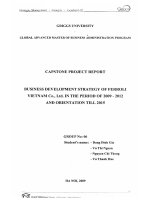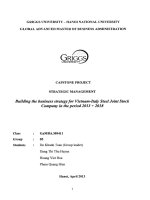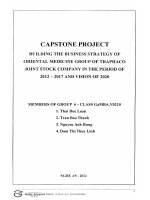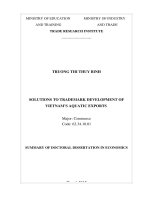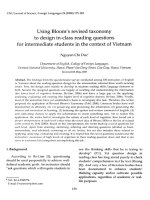Vietnam’s coffee exports to china in the period 2016 2021 advantages and challenges
Bạn đang xem bản rút gọn của tài liệu. Xem và tải ngay bản đầy đủ của tài liệu tại đây (596.84 KB, 64 trang )
1
TABLE OF CONTENTS
Contents
ABSTRACT.................................................................................................5
INTRODUCTION........................................................................................6
1. Rationale of research..............................................................................6
2. Previous researches................................................................................7
3. Objectives of research............................................................................8
4. Subjects and scope of research...............................................................8
5. Research methodology...........................................................................9
6. Structure of research..............................................................................9
CHAPTER 1:..............................................................................................10
OVERVIEW OF VIETNAM’S COFFEE EXPORTS TO CHINA............10
1.1. Overview of export..............................................................................10
1.1.1. The concept of export.......................................................................10
1.1.2. Forms of export.................................................................................10
1.1.3. Roles of export..................................................................................12
1.2. Overview of Vietnam’s coffee export to China...................................14
1.2.1. Overview of Vietnamese coffee product...........................................14
1.2.2. The Chinese coffee market...............................................................17
1.2.2.2. Several principles and rules of coffee imports in the Chinese market
.................................................................................................................... 19
1.2.2.2.1. Tariff barriers..............................................................................19
1.2.3. Potentials of Vietnam’s coffee exports to China...............................22
1.2.3.1. Potentials of Vietnam’s coffee production.....................................22
2
1.2.3.2. Potentials of the Chinese coffee market.........................................24
1.3. Criteria to evaluate advantages and disadvantages of Vietnam’s coffee
export to China...........................................................................................27
1.3.1. Macro-environmental factors............................................................27
1.3.1.1. Legal factors..................................................................................27
1.3.1.2. Cultural and social factors..............................................................28
1.3.1.3. Economical factors.........................................................................29
1.3.1.4. Science and technology elements...................................................30
1.3.1.5. Political factors..............................................................................30
1.3.1.6. International competitive factors....................................................31
1.3.2. Microenvironmental factors..............................................................31
1.4. Standards for exporting coffee to China...............................................33
1.4.1. Products categories...........................................................................33
1.4.2. The principles of humidity and air ensure that coffee goes to China 36
CHAPTER 2: THE CURRENT SITUATION OF VIETNAM’S COFFEE
EXPORT TO CHINA IN THE PERIOD 2016-2021..................................37
2.1. Vietnam’s coffee exports to China in the period 2016-2021................37
2.1.1. The export volume............................................................................37
2.1.2. The export turnover...........................................................................39
2.1.3. Structure of the export coffee product...............................................41
2.1.4. Price..................................................................................................42
2.1.5. Promotion activities..........................................................................44
2.1.6. Distribution channels for agriculture foods in Vietnam....................45
2.1.6.1. Traditional distribution channel.....................................................45
3
2.2. Evaluation of Vietnam’s coffee exports to China in the period 20162021............................................................................................................47
2.2.1. Advantages and achievements..........................................................47
2.2.2. Drawbackacks...................................................................................48
2.2.3. Factors affecting Vietnam’s coffee exports to China in the period
2016-2021...................................................................................................48
CHAPTER 3: RECOMMENDATIONS.....................................................50
3.1. Vietnam's coffee export orientation in the coming period....................50
3.2. Recommendations................................................................................52
3.2.1. Raising awareness for coffee exporters about the Chinese market....52
3.2.2. Having an appropriate export strategy for Vietnamese coffee to the
Chinese market...........................................................................................52
3.2.3. Building and strengthening the link between partners and Vietnamese
coffee exporters..........................................................................................53
3.2.4. Improving the economic and legal environment, promote the
coordination of regulatory agencies............................................................54
3.2.5. Improving competitiveness for enterprises exporting Vietnamese
agricultural products to the Chinese market................................................55
3.2.6. Focusing on solutions to boost coffee exports..................................55
CONCLUSION..........................................................................................57
Vietnamese References...............................................................................58
Foreign References.....................................................................................61
4
The author would like to express sincere thanks to M. Nguyen Hoang Giang
who has devotedly guided and helped the author during the thesis. At the
same time, the author would like to express deep gratitude to the teachers of
Foreign Trade University who have taught during their study and research
at the university.
Being aware of the importance of the graduation thesis, the author has paid
close attention to research and learning. However, due to the limitation of
preparation time, reference materials, professional capacity as well as
practical experience, the thesis cannot avoid limitations and shortcomings.
The author looks forward to receiving the comments of teachers and readers
to make the thesis more complete.
5
LIST OF FIGURES AND TABLES
Table 1.1. China's coffee import tariff
Figure 1.2.3.1: Coffee consumption in China
Figure 1.2.3.2: Rate of coffee bean export to China market
Figure 2.1-1: Vietnam’s Export volume of coffee
Figure 2.1-2.: Rating compare between Vietnam’s export volume of coffee
to China and Global.
Figure 2.1-3 : Vietnam’s export turnover
Figure 2.1-4: Rating comparing Vietnam’s export turnover to China and
Vietnam’s export turnover.
6
ABSTRACT
Vietnam has increasingly deepened relations with China in almost all fields,
especially trade. China is not only a close market but also a market with
great import demand for agricultural and aquatic products to serve domestic
consumption as well as for export processing. At the same time, China is
also the largest and most important export market of Vietnam's agricultural
products for many years, and agricultural products are also the second
largest export industry to China, contributing positively to Vietnamese
export turnover to this market.
Therefore, in order to exploit the potential and available advantages in
exporting agricultural products in general and coffee in particular, to the
Chinese market, Vietnamese agricultural export enterprises must have an
adaptive mindset, not just deal with regulations on export requirements and
conditions. For the above reasons, the author chooses the content "The
7
current situation of Vietnam's coffee exports to the Chinese market" as the
research topic.
INTRODUCTION
1.
Rationale of research
Productivity can be increased by the emphasis on exports which helps
concentrate investment in the more efficient sectors of the economy
(Emery, 1967). Profitable export sectors attract additional investment, a
greater flow of new technology and managerial skills, and increasing
demand (Osano, 2016). In recent years, the Vietnamese government has
been giving export special attention intending to further promote
industrialization and modernization of the country and integrate into the
regional and world economy. Coffee exports are one of the top priorities
and China is a potential market to promote coffee exports.
On the one hand, the coffee business is occupying an important position
worldwide. Especially in Vietnam, coffee is the major export commodity,
second only to rice. Every year in the country, the flourishing of coffee
8
exports benefits the country in many ways. It contributes about 3% to the
GDP of the country annually and about 15% of the total export of
agricultural products in the period 2011-2018. Coffee exports also
contribute to economic restructuring to promote production; It has a
positive impact on creating jobs and improving people’s lives by attracting
millions of laborers to work and earn high and regular incomes; is the basis
for expanding and promoting our country’s foreign economic relations. In
today’s trend of opening up and integrating into the world economy,
Vietnamese coffee is expanding with remarkable achievements. Vietnam’s
coffee exports rank second, only after Brazil, in the list of the world’s
largest coffee export volumes. Moreover, Vietnamese coffee brands, Trung
Nguyen or Vinacafe for instance, are growing their positions in the
international market. Vietnam nowadays is well-known as a powerhouse of
coffee exports and the quality of Vietnamese coffee, especially Robusta, is
much improving.
On the other hand, China is one of the closest and major trading partners of
Vietnam. China is the second-largest economy in the world after the United
States, with a population of over 1.4 billion people. The young population
makes up most of the population structure. Chinese young people and other
social classes are gaining more interest in coffee and consider coffee to be
as important as their traditional tea. Vietnam has a common border of over
1300 km and many trade border gates to China, Mong Cai - Quang Ninh
international border gate for example. China supports cross-border trade
with Vietnam and has issued many preferential policies under the ASEANChina Free Trade Agreement (ACFTA). China is also not a demanding
market for imported agricultural products. Despite certain achievements,
Vietnam’s coffee exports to China still meet difficulties in many aspects.
Being aware that studying and researching Vietnam’s coffee exports to
China is vital, the selected topic is: “Vietnam’s coffee exports to China in
9
the period 2016-2021: Advantages and Challenges” to learn about
achievements and limitations in exporting Vietnamese coffee to China to
make evaluations and propose some recommendations.
2.
Previous researches
At the national level, documentary information about the coffee industry is
mainly on analytical articles or statistical websites such as VICOFA
(Vietnam Coffee and Cocoa Association). At the worldwide level,
documents and figures about the coffee industry are listed on the website of
the World Trade Organization (WTO), the World Coffee Organization
(ICO). There are several research projects and dissertations on coffee, but
most of them are about economic efficiency and development potential; a
number of researches about the coffee market in China. For example,
Coffee market in China explained Chinese coffee consumer trends and
provide some suggestions for firms and retailers to get achievements in the
long run;
a number of researches about Vietnam - China trading
relationship. For instance, Vietnam-China agricultural trade pointed out
several advantages and challenges of the trade relationship between the two
countries focusing on the agricultural fields.
However, those aforementioned are only the most general information
about Vietnam's coffee industry, the world coffee industry, exporting
agricultural products from Vietnam to China in general, or analysts with old
data. Therefore, my thesis focuses on analyzing the situation of Vietnamese
coffee exports to the Chinese market in the period 2016-2021.
3.
Objectives of research
This thesis studies the current situation of Vietnam’s coffee exports to the
Chinese market in the 2016-2021 period, from which to evaluate
10
advantages and disadvantages and propose recommendations based on the
assessment.
4.
Subjects and scope of research
The objective of the thesis is the coffee export activity of Vietnam to the
Chinese market.
Scope of research is as the following:
-
Space: Coffee exports from Vietnam to China.
-
Time: the current situation of Vietnam’s coffee exports to China in
the 2016 - 2021 period.
5.
Research methodology
The author applies several methods including information collecting,
processing, analyzing, comparing, contrasting, predicting, synthesizing.
Tables, figures, charts, etc are also included in the thesis to perform and
analyze the data to figure out trends and fluctuating characteristics of the
research subject.
The author uses the logical method which is based on a theoretical basis, to
analyze data about the current situation of coffee exports from Vietnam to
China so as to provide particular evaluations and recommendations.
6.
Structure of research
To achieve the research purpose, in addition to the table of contents, the list
of acronyms, the list of tables, and the list of references, the thesis contains
3 chapters: The first chapter is “Overview of Vietnam’s coffee exports to
China” where the author provides general information about Vietnam’s
coffee exports and the Chinese market. The second chapter is “The current
11
situation of Vietnam’s coffee exports to China in the period 2016 - 2021”.
In this chapter, the information and data about export volume, export
turnover, price, etc, and assessments of advantages and limitations due to
which are
presented.
Finally,
the
third
chapter proposes
some
recommendations due to evaluations in the last chapter.
CHAPTER 1:
OVERVIEW OF VIETNAM’S COFFEE EXPORTS TO CHINA
1.1. Overview of export
1.1.1. The concept of export
Export, in general, is known as the sale of goods and services from one
country to another based on using currency as a payment method. In the
former mercantilism, the payment method was not money, but also gold,
silver, precious stones… In the modern economic context, money is the
main method, and it is possible to use the currency of either party or the
currency of a third country.
In Article 28, Clause 1 of Vietnam’s 2005 Commercial Law, it is stated that
“Export of goods is the act of bringing goods out of Vietnam’s territory or
into a special area within the territory of Vietnam, which is considered an
economic zone. separate customs area as prescribed by law”. Thus,
according to the law of Vietnam, export is basically the sale of goods to
foreign countries, to countries other than Vietnam.
12
1.1.2. Forms of export
In Vietnam, there are four main forms of export
Direct export is a popular form of export today. The seller and the buyer are
based on direct transactions, agreements, and negotiations on the interests
of each party under the law of each country taking part in the transaction
and then conclude the final contract. This shows the autonomy of
enterprises in trading goods, finding market partners on the basis of market
research and consumer tastes in the target country. However, the enterprise
will be the unit that directly conducts the business and is responsible for
transaction procedures, costs incurred, profits earned, and losses when
doing business.
Entrusted export exists with two main subjects including the domestic
enterprise and the market (the export-oriented nation), plus an intermediary
enterprise operating in foreign countries. This form is applied when
domestic enterprises encounter barriers in terms of financial ability,
partners, or language. In that case, they will negotiate and entrust
intermediary enterprises to export goods. After receiving the entrustment,
the intermediary enterprise will undertake all export procedures of the
domestic enterprise, the costs incurred, commissions, and the right to
receive after the entrustment, which is stated in the contract between the
two parties.
On-spot export is the form of exporting goods produced by a domestic
enterprise, which sells to foreign traders or enterprises, but delivers all the
goods received to another designated domestic enterprise. According to
Article 86, Circular No. 38/2015/TT-BTC on “Customs procedures for onspot exported and imported goods”, there are three main types of on-spot
exported goods.
13
The first is handmade products; leased or borrowed machinery and
equipment; surplus raw materials and supplies; scrap and discarded
products under the processing contract as prescribed in Clause 3, Article 32,
Decree 187/2013/ND-CP. Second is goods traded between domestic
enterprises and export processing enterprises, enterprises in non-tariff
zones. Third is goods traded between Vietnamese enterprises and foreign
individuals and organizations that do not have a presence in Vietnam and
are designated by the trader to deliver and receive goods with other
enterprises in Vietnam.
Temporary import and re-export is a form in which Vietnamese traders
temporarily import goods and services of a domestic production and
business enterprise. Then they use the same goods to export to other
countries outside the territory of Vietnam. This form has both import and
export processes, thus the amount of foreign currency revenue will be larger
than the initial capital spent.
1.1.3. Roles of export
1.1.3.1. An important driver of economic growth
Export of goods and services is an international activity, taking place for all
subjects in the market and under the control of the Government. The
purpose of exporting is to bring their goods and services to other countries
in the world. From that business will help the subjects earn more foreign
currency. For a socialist country, with a developing economy like Vietnam,
the open strategy of the economy through export plays an important role.
Because when exporting, it is possible to earn a lot of foreign currency,
have access to scientific and technological innovation, and science and
technology transfer. Besides, the opening of the economy also helps the
country gain business lessons. Experience from developed countries
14
combined with government policies to improve the economy is likely to
increase economic growth, and narrow the gap with developed countries.
1.1.3.2. An opportunity to improve the quality of Vietnamese products and
goods
Exporting is not simply being able to export goods and services to a country
other than Vietnam. In fact, goods that are cleared by Customs and
consumed in other countries must undergo a rigorous inspection to ensure
quality standards in the exporting country. It requires a serious and
thorough investment, applying new production and business methods, and
innovating equipment and production technology to further improve
product quality. This not only helps export goods and services have a more
convenient way to enter the country’s economic market share but also
affirms the important position of high-quality Vietnamese goods and
products.
1.1.3.3. A driving force for economic restructuring
One of the main export roles is the premise for the Vietnamese economy to
move in a more appropriate direction. Indeed, in the context of an open
economy, the Government focuses much on exports, especially on key
export industries such as rice, cashew nuts, textiles, seafood, etc. Along
with that, it also entails the development of a supply chain from raw
material production to processing. This helps economic entities to have
more access to automated production methods and chain-specific
production models. As a result, the country’s structure changed more
quickly.
1.1.3.4. A factor creating jobs and improving people’s living standards
The promotion of exports requires goods and products to be made in large
quantities, raising a problem of labor supply for enterprises and the
15
Government. In the context that our country is a country with a young
population, exporting is an opportunity to help workers find jobs suitable
for each skill level. Workers will earn a higher income and have a higher
standard of living.
1.1.3.5. A premise to expand and promote foreign economic relations
Exports and external economic relations have a two-way relationship. In
fact, exporting goods and services to a country will help Vietnam have
more trade relationships in the international market, and simultaneously
enhance the role and stature of the country. On the other hand, external
economic relations with other countries are the premise to help Vietnam
understand the market for export consideration. Other countries will also
have a more intuitive view of Vietnamese goods and then consider
importing goods from Vietnam. Therefore, it can be said that exports are the
driving force behind Vietnam’s foreign relations with partners all over the
world.
Overall, exports play an important role in the national economy, promoting
economic restructuring to participation in socio-political issues. Exporting
is also the process that helps our country promote the stature of Vietnamese
goods as well as shortens the economic gap and disparity with other
countries.
1.2. Overview of Vietnam’s coffee export to China
1.2.1. Overview of Vietnamese coffee product
Coffee is a black beverage that contains caffeine and is produced from
roasted whole beans. Currently, coffee trees are grown in more than 50
countries and are popular in most countries around the world.
1.2.1.1. Historical development
16
Arabica coffee is the first coffee introduced to Vietnam in 1857, through
several French missionary priests. It was initially planted at Catholic
churches in some provinces in the North, such as Ha Nam and Phu Ly, later
in Thanh Hoa, Nghe An, and Ha Tinh provinces. After that, the coffee was
spread to the Central area such as Quang Tri and Quang Binh. After the
war, coffee gardens here continue to be maintained. Therefore, this area has
a very high distribution rate of coffee. When the coffee trees came into the
South of Tay Nguyen and Southeast area, people realized that here was the
most suitable place to grow coffee.
In 1908, the French imported two more varieties of coffee into Vietnam,
Robusta, and Liberica. After a while, Western colonists saw that Arabica
coffee did not bring high economic efficiency. They brought the coffee
from Congo to plant in Tay Nguyen. This area has become the largest
coffee-growing one in Vietnam, both in terms of scale and reputation.
Nowhere in Vietnam has coffee become famous like in Buon Ma Thuot.
1.2.1.2. Classification
There are thee main coffee varieties in Vietnam: Arabica coffee, both
Robusta coffee, and Liberica/Excelsa coffee.
• Arabica coffee
This is the coffee with the highest economic value among the coffee tree
species. Arabica accounts for 61% of coffee products worldwide. In
Vietnam, Arabica only accounts for about 5% of the total area and 8% of
the total coffee output, scattered in the northern mountainous provinces
such as Lai Chau, Son La, Yen Bai; in Central provinces such as Thanh
Hoa, Quang Tri, Quang Nam, and a part in Lam Dong province.
Worldwide, Arabica is grown throughout Latin America, Central and East
Africa, India, and parts of Indonesia. Arabica coffee is also called Brazilian
17
Milds if it comes from Brazil, Colombian Milds if it comes from Colombia,
and Other Milds if it comes from other countries. Brazil and Colombia are
the two main exporting countries of this coffee, the quality of their coffee
are well-known. Other major exporting countries include Ethiopia, Mexico,
Guatemala, Honduras, Peru, and India.
In the market, Arabica coffee is more valuable than Robusta coffee because
of its delicious taste and less caffeine content. A whole bag of Arabica
coffee (60 kg) usually costs twice as much as that of Robusta coffee.
Vietnam is the second-largest coffee exporter in the world, but mainly
Robusta coffee. It is difficult for Vietnam to cultivate this coffee because
the altitude is not suitable. Besides, the Arabica coffee plant suffers much
from pests and diseases, so compared to Robusta, it is not very economical.
• Robusta coffee
Robusta is Vietnam’s crucial coffee tree, accounting for 95% of the
cultivated area, mainly grown in Tay Nguyen and some Southeast provinces
such as Dong Nai, Binh Phuoc, Ba Ria - Vung Tau. Around the world,
Robusta is grown in West and Central Africa, Southeast Asia, and a small
part of Brazil. The largest coffee exporter in the world is Vietnam. Other
important exporting countries include Côte d’Ivoire, Uganda, Brazil, India.
Robusta coffee contains higher caffeine content and has an impure taste
than Arabica coffee, so it is less valuable. The price of a whole bag of
Robusta is usually only half that of Arabica.
• Liberica / Excelsa coffee
In Vietnam, Liberica is grown mainly in provinces such as Nghe An, Gia
Lai, and Kon Tum, which have favorable conditions for developing
industrial crops but not favorable for developing coffee. This is also the
reason Dak Lak and especially Buon Ma Thuot is considered the capital of
18
coffee, but there are few areas to grow this type of coffee. In Tay Nguyen,
Liberica coffee is often harvested later than other coffee species because it
blooms thanks to rainwater. The fruit is harvested in the 12th lunar month,
after other coffee species. Sometimes, Liberica planted in rows with a
distance of 5-7m per tree can be used as a windbreak for Robusta coffee.
Worldwide, Liberica is grown in Malaysia and West Africa, but because of
its unpopular taste, only a tiny amount is traded in the world.
1.2.1.3. Features of coffee production and business
First, the coffee tree is seasonal, which has a great influence on the coffee
business. This feature affects even big coffee producers and traders such as
Brazil and Colombia. During the harvest season, the price of ratification is
low, and at other times it increases significantly because of the scarcity of
goods. It is for this reason that coffee exporting countries and coffee export
businesses will gain advantages when they have enough finance to stock up
on coffee.
Second, the coffee tree is a long-term industrial plant, taking about 3-5
years until harvest season. It is this problem that affects producers,
especially those with limited financial resources, who have to borrow
capital from banks to invest in growing coffee. When the coffee market
changes, it is difficult for them to seize the opportunity right away. Thus,
there is a high requirement for farmers to know how to research and
forecast the general trend in order to make profitable investments.
Third, weather conditions heavily influenced coffee production. In years of
drought and flood, the coffee crop failed, affecting the exported coffee,
thereby indirectly affecting the world’s coffee market. Predictions from
experts, national-leveled plans as well as coffee export businesses can all be
messed up.
19
Furthermore, trading in coffee has high risks, especially business forms
related to future contracts, differential prices,...
1.2.2. The Chinese coffee market
1.2.2.1. Overview of the Chinese coffee market
Coffee was first introduced to China in the late nineteenth century by a
French missionary in Yunnan province. Coffee production then waited for
more than a century, until 1988 when the Chinese Government, in
collaboration with the World Bank and the United Nations Development
Program, began a project to regenerate the industry. Big companies like
Nestlé also encourage coffee to grow in the region (ICO, Coffee in China,
2014).
According to market research by Euromonitor, the Chinese coffee market is
mainly composed of instant coffee. Indeed, instant coffee accounts for
about 99% of retail sales by volume and 98% by value, although roasted
coffee is growing at a faster rate. The most common types of instant coffee
are 3-in-1 products that contain coffee, sugar, and whiteners, as well as
flavorings.
The growing popularity of coffee shops and coffee culture has fueled the
growth of the roasted coffee market. Coffee shop sales are growing faster
than retail sales, with the number of cafes in China estimated at 13,834 at
the end of 2013. As incomes rise, consumers tend to consume more highend products. Retail sales of coffee pods are the most dynamic growth
although they are still a niche product (Nguyen Hoang My Phuong, 2015).
Coffee is mainly grown in Yunnan province, which accounts for over 95%
of China’s coffee production. Yunnan is a traditional tea-growing province.
However, the mountainous climate (average altitude is about 2,000 m) and
mild climate are very suitable for coffee production. Yunnan also borders
20
Vietnam, Laos, and Myanmar, at the heart of the coffee belt. It is a large
province with an area of 394,000 square kilometers and a population of 46
million. There is also a small amount of Robusta coffee grown on Hainan
Island, in the south of China, and in the southeast of Fujian.
1.2.2.2. Several principles and rules of coffee imports in the Chinese
market
1.2.2.2.1. Tariff barriers
Besides the applied tariff schedule for goods imported from countries that
are not WTO members, China also applies the Most Favored Nation (MFN)
Tax Preferential System to several WTO members. Vietnam’s coffee
exports are entitled to preferential treatment at the standard MFN level.
Therefore, the tax rate applied to coffee imported from Vietnam will be
lower than the normal tax rate applied to this item. Moreover, Vietnam
mainly exports raw coffee to China, which is hardly affected by import
taxes. This has helped increase the competitiveness of Vietnamese coffee.
Table 1.1. China's coffee import tariff
(Unit: %)


